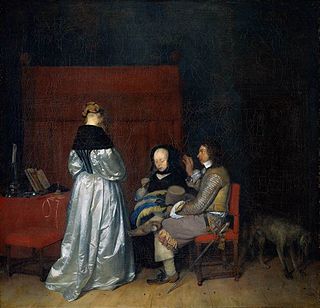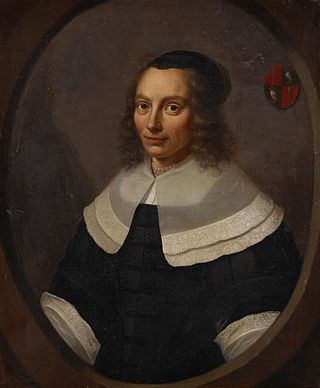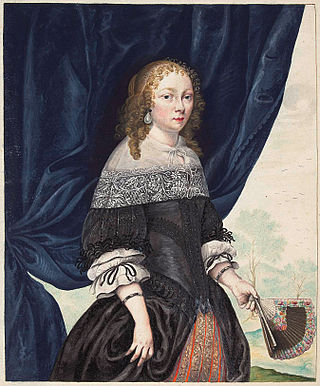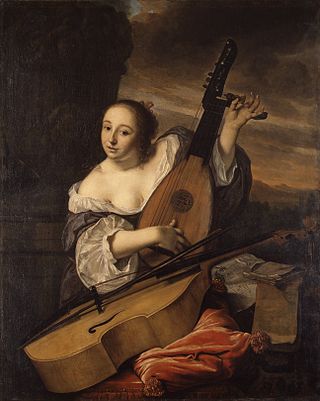
CasparNetscher was a Dutch portrait and genre painter. He was a master in depicting oriental rugs, silk and brocade and introduced an international style to the Northern Netherlands.

Gerard ter Borch, also known as Gerard Terburg, was a Dutch Golden Age painter mainly of genre subjects. He influenced his fellow Dutch painters Gabriel Metsu, Gerrit Dou, Eglon van der Neer and Johannes Vermeer. According to Arthur K. Wheelock Jr., Ter Borch "established a new framework for subject matter, taking people into the sanctum of the home", showing the figures' uncertainties and expertly hinting at their inner lives. His influence as a painter, however, was later surpassed by Vermeer.

Frans van Mieris the Elder, was a Dutch Golden Age genre and portrait painter. The leading member of a Leiden family of painters, his sons Jan (1660–1690) and Willem (1662–1747) and his grandson Frans van Mieris the Younger (1689–1763) were also accomplished genre painters.

Hendrick Jansz ter Brugghen was a Dutch painter of genre scenes and religious subjects. He was one of the Dutch followers of Caravaggio – the so-called Utrecht Caravaggisti. Along with Gerrit van Hondhorst and Dirck van Baburen, Ter Brugghen was one of the most important Dutch painters to have been influenced by Caravaggio.

Eglon van der Neer was a Dutch painter of historical scenes, portraits and elegant, fashionable people, and later of landscapes.

The Gallant Conversation is an oil-on-canvas painting from circa 1654 by Gerard ter Borch. A late 18th century French print of the work is titled The Paternal Admonition, apparently believing it showed a father reprimanding his daughter, but modern art historians see it as a conversation between two prospective lovers, either a discussion of a betrothal or, more likely, a customer propositioning a prostitute in a brothel. There are two versions made by the painter, one at the Rijksmuseum, in Amsterdam, and the other at the Gemäldegalerie Berlin. The two paintings are dated to around 1654. The Amsterdam version is 71 cm by 73 cm, with the extra centimeters on the right being taken up by a dog and a door. The dimensions of the Berlin painting is smaller, 70 by 60 cm.

Lucia Wijbrants or Wybrants was the daughter of Johannes Wijbrants, a silk merchant, whose ancestors had moved from Stavoren to Antwerp. After 1585 when Antwerp was occupied by the Spanish army, the family moved to Amsterdam and lived in a house in the Warmoesstraat, then a fashionable shopping street. They had eight more children: only Hendrick (1623–1669), Helena (1628–1721), and Johannes survived.

Johan de Graeff, also Jan de Graeff - patrician of Amsterdam, Free Lord of Zuid-Polsbroek - was a member of the De Graeff - family from the Dutch Golden Age. His political Position was that of the Dutch States Party.

Jan Verkolje or Johannes Verkolje was a Dutch painter, draughtsman and engraver. He is mainly known for his portraits and genre pieces of elegant couples in interiors and, to a lesser extent, for his religious and mythological compositions. He was a gifted mezzotint artist. Trained in Amsterdam, Verkolje spent his active professional career iLien Delft where he had access to powerful patrons.

Agneta de Graeff van Polsbroek, was a patrician woman from the Dutch Golden Age. She became known as the mother-in-law of Johan de Witt.

Gesina ter Borch was a Dutch Golden Age watercolorist and draftswoman, whose work mostly consists of watercolor paintings in albums. Most of her work captured her observations of family life, current events, and fashionable people. In addition to the visual arts, Gesina wrote love poetry.

Jan Gildemeester Jansz. was a Dutch art collector.

The Art Gallery of Jan Gildemeester Jansz is a painting created by the Dutch painter Adriaan de Lelie in 1794–95. It is part of the collection of the Rijksmuseum Amsterdam, executed in oil paint on panel. It depicts the art collector Jan Gildemeester Jansz in the midst of his large collection of paintings, showing them to friends.
Van Maanen is the name of a Dutch patrician family, originating in the Duchy of Guelders. The family takes its name from the town of Manen, situated south of the city of Ede in the province of Gelderland.

The Musician (1662) is an oil on canvas painting by the Dutch painter Bartholomeus van der Helst. It is an example of Dutch Golden Age painting and is part of the collection of the Metropolitan Museum of Art.
Eduard Siegfried"Eddy"de Jongh is a Dutch art historian specialized in iconography. He was professor of art history with a teaching assignment in iconography at Utrecht University between 1976 and 1989.

Adriaen van der Goes was a Dutch Grand pensionary. He was the son of Grand pensionary of Holland Aert van der Goes, and he succeeded his father in this position.

Countess Anne Joanne of Nassau-Siegen, German: Anna Johanna Gräfin von Nassau-Siegen, official titles: Gräfin zu Nassau, Katzenelnbogen, Vianden und Diez, Frau zu Beilstein, was a countess from the House of Nassau-Siegen, a cadet branch of the Ottonian Line of the House of Nassau, and through marriage Lady of Brederode, Vianen, Ameide and Kloetinge.

Seated Girl in Peasant Costume is an oil-on-panel painting by Dutch artist Gerard ter Borch, created c. 1650. It is held in the Rijksmuseum, in Amsterdam.

Ariane van Suchtelen is a Dutch art historian and museum curator, currently at the Mauritshuis.


















